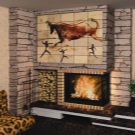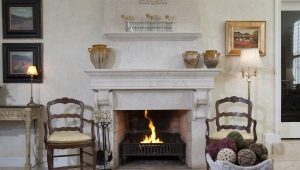Fireplace tiles
Decorating a fireplace tile is one of the most simple and low-cost ways to design a hearth. This coating does not require special care, but the selection of material must be approached very carefully.
How to choose the right material
For finishing the fireplace will suit any tile that can be veneered furnace. When selecting a tile are important parameters such as:
- Heat capacity. Tiles help keep you warm
- Heat resistance. Facing the fireplace is only possible that type of tile, which has a high resistance to high temperatures.
- The tile must be durable. Its strength factor should be at least 30 tons / sq. M.
- The material must be environmentally friendly. In this case, when heated into the air, fewer harmful chemicals will be emitted, which is important in a residential area.
When choosing a tile, a careful inspection is important. The tile should be flat, both outside (which will ensure aesthetic appearance) and from the inside.If the tile is uneven from the inside, then during laying it may lie badly on the brick, which will lead to laying defects.
Cracks in the tile suggest that the material is brittle and is likely to crack under the influence of high temperature, even if there are cracks only on the wrong side.
It is recommended to buy 10-15% more material than necessary. This excess will be used to trim the tiles to convex parts and for possible replacement during operation.
The tile for finishing is not recommended to use. It is not intended for use in high temperature conditions.
The tile does not require special care, it is easy to remove dust, soot and other contaminants from it. It is easier to lay large tiles than small ones, but it is more difficult to fit under the ledges and niches.
The variety of types of finishing tiles allows you to choose options for every taste.
Types of cladding
- Terracotta tiles. This tile has high strength and has proven itself for many years. Differs specific reddish tint, the so-called terracotta.
- Majolica - the same terracotta tile, but covered with glaze. It is beautifully and diversely painted.
- Clinker tiles. It is an alternative to finishing brick. A large variety of colors of this material allows it to fit into any interior.
- Porcelain tiles. This material is good primarily because it mimics a variety of materials, such as granite, marble or terracotta.
- Chamotte tile (for example, Feldhaus Klinker). Its most important feature is single-piece, and not mass production. This approach allows the use of fireclay tiles in any interior. As well as in the decoration of stoves and fireplaces of all shapes and sizes.
- Tiles are one of the most beautiful types of finishes. The main feature that distinguishes the tiles from the usual ceramic tiles, the presence of rumpy, which helps to consolidate the tile and improves heat saving.
Styling tips
Laying ceramic tiles does not require special tools. For cutting elements of the desired size fit the usual Bulgarian. To use a tile costs no more than 8 mm thick.
Preparing the fireplace and cladding is as follows:
- Remove the old finish, if available along with plaster and paint. Clean and deepen seams between bricks, moisten the surface with water.
- Level the brick surface with heat resistant mastic or clay mortar. Wait until the material dries. If the surface is not very flat, level it with a grinding wheel. The better the surface is leveled, the easier it is to lay tile.
- Apply primer. It helps to reduce dust and contributes to the uniform drying of the previous layer. Leave the primer for two hours until completely dry.
- The glue is mixed according to the instructions using a mixer or a drill with the desired nozzle. Glue for temperatures above 500 degrees in residential premises is not needed, the surface of the fireplace does not warm up to this level. A large number of solutions presented by current manufacturers will allow you to easily select the appropriate material.
- Begin to lay the tile from the bottom, applying glue with a notched trowel. To make the same distance between the tiles use special corners. Every few rows check the masonry level vertically and horizontally.
- After masonry finishing, jointing is performed. At the request of the seams can be convex or depressed, which is achieved by applying a solution of a special figured element.
- The tile dries two days at room temperature. After this period, the fireplace can be melted.
Interior design
Decorating fireplaces with decorative tiles is a great idea for decorating the hearth in such a way that it fits into the interior as well as possible. The tile is suitable for all types of fireplaces: corner, semi-circular, closed and others.




















































